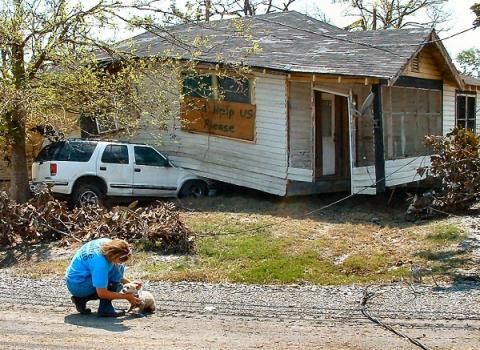What to Do When Disaster Strikes

It’s one of those things you don’t think about until it’s too late: It’s early Sunday morning; you slip out of bed and get ready to walk out to the barn to feed the horses. The wind picks up. Lightning bolts crash close by, the horses are spooked, and one rears up and cuts himself on the stall door. In a panic, you try to wrap a cloth around the cut when lightning hits a tree close to the barn. A fire breaks out. You open all the stalls to get the horses out, but the wind is tearing the side of the barn off….
How to respond in the face of disaster is a topic that everyone needs to learn. In moments, both human and animal life can depend on quick thinking, and that thinking comes from planning and preparation long before it’s needed.
With the threat of tornado season here, and hurricane season just around the corner, the First Response Unit of Habitat for Horses is in full preparation mode. Under an agreement with Galveston County, we are responsible for search and rescue, temporary housing and the return of all equine displaced by a disaster.
We cut our teeth during the aftermath of Katrina by bringing in around 200 horses to the staging area. Immediately after Katrina, Rita struck, and we once again went into action. When Hurricane Ike hit Galveston, the Sheriff’s Office put us to work doing search and rescue, both on the island and the mainland. We rounded up dozens of horses and donkeys, set up the staging area and provided veterinarian care for the sick and injured. Purina brought us truckloads of feed and others donated thousands of pounds of hay.
The sad part of our response isn’t the horses saved, it’s the lives lost because animal owners did not give enough forethought into what they should do when disaster hits. Getting horses out of the barn when a fire starts is an example. Do you know what you should do to lead them to safety? The Barn Disaster Planning page is a great place to start.
There are hundreds of articles on the internet related to disaster planning and animals. Spend a few hours reading, then make plans for yourself, your family and your animals. Should you shelter in place or relocate? If the power fails will you be able to provide water?
Your next thoughts should be about your neighbors and your community. Flooding, fires, and tornados know no bounds. Who responds to all the animals and the cries for help? You don’t need to be “in charge” to be helpful. There are hundreds of chores to do around a staging area, and trained volunteers are desperately needed and welcomed. But get plugged in before disaster strikes. Find out who is in charge of your county response team and help set up training sessions for horse first aid stations and evacuation plans.
As you become more involved in disaster planning and preparation, you’ll find that trained responders have taken courses under the guidelines of the FEMA Emergency Management Institute. This training is essential for anyone involved in disaster response and is required for all our volunteers who intend to assist us when the call comes for our Disaster Response Units.
The Incident Command System and National Incident Management System training courses can be found here.
At a minimum, take the ICS-100 course. It’s online, it’s easy, and you immediately receive your certification. Print it out and save it. If you decide to show up to volunteer with us or anywhere else, you can proudly say, “I’m prepared to help.”

